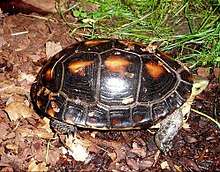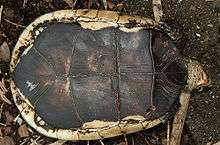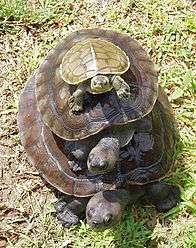Chinese box turtle
The Chinese box turtle (simplified Chinese: 食蛇龟; traditional Chinese: 食蛇龜; pinyin: shíshéguī; lit.: 'Snake-eating turtle'), also known as the yellow-margined box turtle, or golden-headed turtle, is a species of Asian box turtle. Taxonomically, it is called Cuora flavomarginata.[6]
| Yellow margined box turtle | |
|---|---|
 | |
| Ryukyu box turtle (Cuora flavomarginata evelynae) | |
| Scientific classification | |
| Kingdom: | Animalia |
| Phylum: | Chordata |
| Class: | Reptilia |
| Order: | Testudines |
| Suborder: | Cryptodira |
| Superfamily: | Testudinoidea |
| Family: | Geoemydidae |
| Genus: | Cuora |
| Species: | C. flavomarginata |
| Binomial name | |
| Cuora flavomarginata | |
| Synonyms[2] | |
Anatomy
C. flavomarginata has a highly domed shell, the carapace and plastron of which are a dark brown with a cream-yellow stripe on the vertebral keel. The edge of the plastron is lightly pigmented due to the marginal scutes' and plastral scutes' lighter pigmentation near their edges. The skin on the limbs is brown, while the top of the head is pale green. Each side of the head has a yellow line extending from behind the eye backward. The skin beneath the head and between the limbs is a lighter pinkish color.
The name box turtle refers to C. flavomarginata's ability to bring the plastron to the edges of the carapace. This is enabled by a hinge on the plastron and ligaments connecting the carapace and plastron, which allows for limited movement.
The forefeet have five claws, while the rear have four.
The external difference between male and female C. flavomarginata is slight. Males have a broader tail than females that is almost triangular in shape.
Distribution
C. flavomarginata is found in Central China: Hunan, Henan, Anhui, Hubei, Chongqing, eastern Sichuan, Zhejiang & Jiangsu provinces (generally along the Yangtze drainage).[7] It is also found in Taiwan and Japan, specifically the Ryukyu Islands, Ishigaki, and Iriomote.[8]
Ecology and life history
Trophic ecology
C. flavomarginata is omnivorous, and will eat a large variety of foods. "Adults favor earthworms, frozen pinkies (defrosted), snails, slugs, and mealworms. They also eat dry trout chow and moistened dry cat food, canned cat food; fruits including strawberries, bananas, cantaloupe, and papaya; and vegetables including grated carrots, corn on the cob, and squash. Leafy greens are ignored. Invertebrates that the turtles hunt for include June bug (Phyllophaga) larvae and slugs being principal prey."[9]
Systematics and taxonomic history
In 1863, John Edward Gray described the species as Cistoclemmys flavomarginata.[1] It was later moved to Cyclemys, and then to Cuora. In the 2012 issue of the Turtle Taxonomy Working Group's Checklist, the species is listed as Cuora with two recognized subspecies.[2]
Two subspecies have been recognised:
This species has hybridized with Mauremys japonica in captivity and with female Ryukyu black-breasted leaf turtles both in captivity and in the wild.[10]



References
- Gray, John Edward. 1863. Observations on the box tortoises, with the descriptions of three new Asiatic species. Proceedings of the Zoological Society of London 1863:173–179.
- Turtle Taxonomy Working Group [van Dijk , P.P., Iverson, J.B., Shaffer, H.B., Bour, R., and Rhodin, A.G.J.]. 2012. Turtles of the World, 2012 update: annotated checklist of taxonomy, synonymy, distribution, and conservation status. Chelonian Research Monographs No. 5, pp. 000.243–000.328, doi:10.3854/crm.5.000.checklist.v5.2012, "Archived copy" (PDF). Archived from the original (PDF) on 2013-01-04. Retrieved 2014-04-19.CS1 maint: archived copy as title (link)
- Hsü Hsi Fan. 1930. Preliminary note on a new variety of Cyclemys flavomarginata from China. Contributions from the Biological Laboratory of the Science Society of China, Zoological Series 6(1):1–7.
- Yeh Hsiang-k'uei. 1961. The first discovery of a box-turtle in China. Vertebrata PalAsiatica 5:58–64.
- Ernst, Carl H. and Lovich, Jeff rey E. 1990. A new species of Cuora (Reptilia: Testudines: Emydidae) from the Ryukyu Islands. Proceedings of the Biological Society of Washington 103:26–34.
- "ITIS Standard Report Page: Cuora flavomarginata". Integrated Taxonomic Information System. Archived from the original on 2004-11-19. Retrieved 2006-06-07.
- Fong, J.; Parham, J. F. & Fu, J. (2002). "A reassessment of the distribution of Cuora flavomarginata Gray 1863 on mainland China" (PDF). Russian Journal of Herpetology. 9 (1): 9–14. Archived (PDF) from the original on 2016-08-04. Retrieved 2012-08-04.
- Peter Uetz; Jakob Hallermann. "Cuora flavomarginata (GRAY, 1863)". The Reptile Database. Archived from the original on 2016-05-28. Retrieved 4 August 2012.
- Connor, Michael J; Vickie Wheeler (October 1998). "The Chinese Box Turtle". Archived from the original on 2006-06-13. Retrieved 2006-06-11.
- Buskirk, James R.; Parham, James F.; Feldman, Chris R. (2005). "On the hybridisation between two distantly related Asian turtles (Testudines: Sacalia × Mauremys)" (PDF). Salamandra. 41: 21–26.

